What is the back screen in basketball
The back screen, sometimes referred to as a rip screen, consists of basketball action that occurs when one offensive player is able to set a screen behind a defender who is guarding a second offensive player and after that, the second offensive player could then use that screen to get open, particularly near the basket, for a potential scoring opportunity.
Generally speaking, the standard or default type of back screen is typically set near the high post area with the screener directly facing the half court line.
However, it is also possible to set a back screen by having a screener face the sideline at an angle. In that case, the angled type of back screen is typically set near the mid-post extended area inside of the three-point arc.
Furthermore, there is a special type of back screen that is commonly referred to as a flex screen. This particular basketball screen is a staple of the Flex offense and the screener typically sets it in the area between the low post block and the adjacent corner while facing that same corner.
Moreover, there is a type of back screen that could be used against an on-ball defender, commonly known as a flat ball screen. This particular on-ball screen is generally set beyond the three-point arc and it is typically used as a pressure release for the player in possession of the ball.
Why is the back screen potentially effective
The back screen is potentially effective because it is generally difficult for the defender to avoid the screen, particularly without foreknowledge of the offensive action via scouting and/or additional help from at least one other defender in the form of communication that calls out the screen or by way of a tactic such as a defensive switch.
As an example, let’s say that there are three offensive players, denoted simply as player A, player B, and player C. Also, let’s say that there are three defenders, denoted as defender A, defender B, and defender C, that guard each of those offensive players, specifically with man to man defense.
Next, let’s say that player A has possession of the ball at the top, player B is near the right side wing, and player C is initially near the right side low post area.
Following that, let’s say that player A passes the ball to player B and after that, player A cuts to the basket via a back screen set by player C near the right side high post elbow area.
Assuming that the defenders do not have foreknowledge of the offensive action, if the teammates of defender A do not call out the back screen or if defender C does not switch with defender A, then there is probably a moderate chance that defender A would get caught on the back screen of player C.
This is even more detrimental if defender A does not jump to the ball upon the initial pass from the top to the wing.
That would essentially mean that player A could potentially execute a face cut against defender A and at the same time, the chance of defender A being impeded by the back screen would most likely increase significantly.
Afterwards, if the back screen is successful, then player A would more than likely be open near the basket and could receive the ball from player C, which would result in a scoring opportunity via a layup or dunk.
What are examples of basic back screen actions
Example 1 – High post elbow
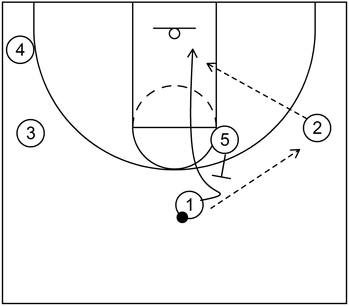
This is an example of a back screen executed near the high post elbow area.
To demonstrate, 2 receives the ball from 1 and after that, 1 cuts to the basket via the back screen set by 5. Next, 1 receives the ball again from 2 and then, 1 scores at the rim via a layup or dunk.
Example 2 – Angle
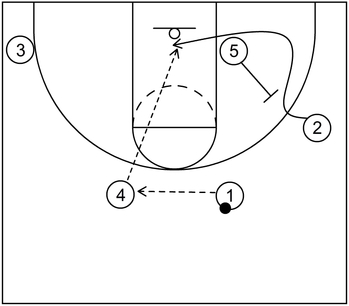
This is an example of a back screen executed near the mid-post extended area at an angle. Furthermore, this type of back screen is utilized as a part of the basic scoring options within the Swing offense as well.
To start the action, 4 receives the ball from 1 and when that occurs, 2 cuts to the basket via the angled back screen set by 5.
Following that, 2 could receive the ball from 4 and score at the rim by way of a layup or dunk.
Example 3 – Flex
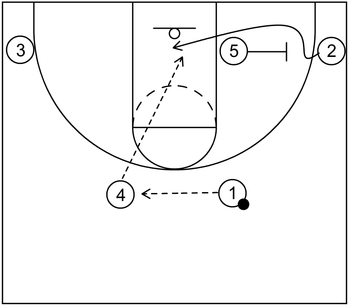
This is an example of a back screen executed in the area between the low post and the corner as a part of the Flex offense.
To begin, 4 receives the ball from 1 and after that happens, 2 cuts to the rim via the flex back screen set by 5.
Next, 2 could receive the ball from 4 and score at the basket by way of a layup or dunk.
Example 4 – Chin
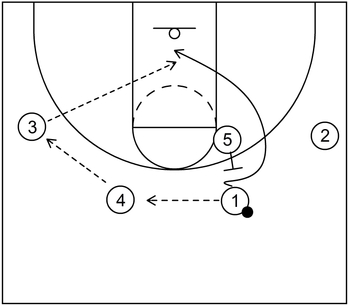
This is an example of a back screen, particularly from the Chin series within the Princeton offense. To start, 4 receives the ball from 1 and then, 3 receives the ball from 4.
Following that, 1 cuts to the basket by way of the back screen near the right side high post elbow set by 5. From there, 1 could receive the ball from 3 and score at the rim if that is open.
Example 5 – Shuffle
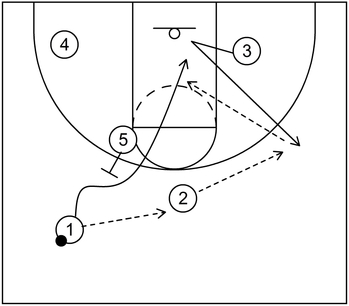
This is an example of a back screen utilized within the Shuffle offense. To start the action, 2 receives the ball from 1 and then 3 executes a V-cut to receive the ball from 2.
Next, 1 executes a shuffle cut to the basket, receives the ball from 3, and scores at the rim.
Example 6 – Flat Ball Screen – Transition
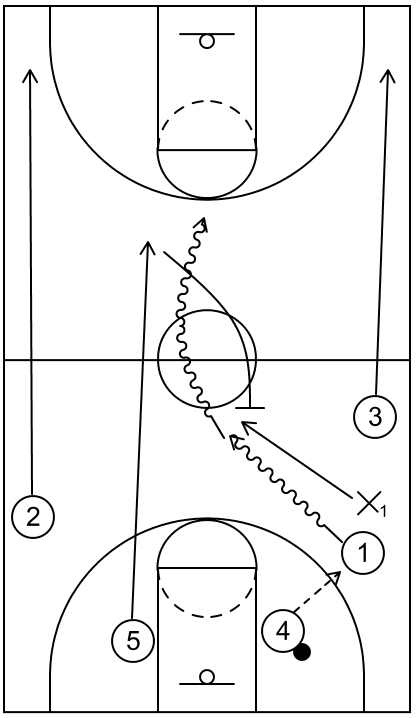
This is an example of a special back screen utilized as a flat ball screen within transition offense. At the beginning, let’s say that the opposing team missed a field goal attempt and that led to a defensive rebound by 4.
Once 4 gathers the ball, 2 and 3 immediately sprint towards the three-point corners in the frontcourt while 5 initially runs toward the rim.
At the same time, 1 is near the free throw line extended area in the backcourt on the strong side with their back to the sideline and hands ready to receive the ball.
From that point, 1 receives the ball from 4 via the outlet pass and then 1 begins to dribble towards the frontcourt, particularly down the middle.
However, X1 extends the defensive pressure in the backcourt to impede the speed and pace of 1 during the transition offense phase.
Following that, 5 stops running towards the rim and instead, 5 turns around to set a flat ball screen in an attempt to block X1 while creating dribbling separation for 1.
Afterwards, 1 uses that on-ball screen and tries to get dribble penetration towards the basket for a scoring opportunity.
Alternatively, 2 or 3 could possibly receive the ball via a kick pass from 1, which could result in potential three-point jump shots.
Affiliate Disclosure: I may earn a commission on qualifying purchases made through the links below.
What are examples of offensive basketball plays that use the back screen
Example 1
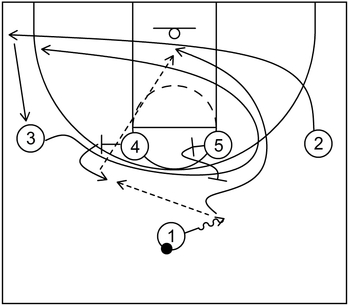
This is an example of a 1-4 high quick hitter that utilizes the back screen to score at the rim, particularly for an athletic point guard.
It is derived from insights within The Best Quick Hitters & Late Game Plays from the 2016 Olympics by Fran Fraschilla.
To start, 1 dribbles from the top to the right slot and as that happens, 2 cuts from the right side wing towards the left side corner.
At the same time, 3 executes an Iverson cut from the left side wing to chase after 2 and immediately following that, 4 pops out to receive the ball from 1.
Next, 2 continues the cut from the left side corner to the vacant left side wing while 3 eventually fills the unoccupied left side corner.
From there, 1 quickly cuts to the basket via the back screen set by 5 and afterwards, 1 could receive the ball from 4, especially by way of a lob pass to complete an alley-oop scoring opportunity at the rim.
Example 2 – Part 1
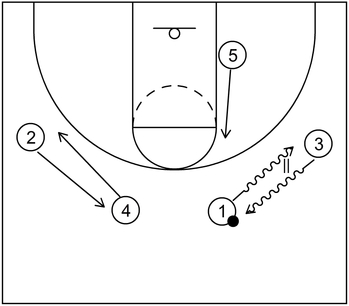
This is an example of a basketball play that uses two forms of back screens to create scoring opportunities near the rim.
It is based on insights within Princeton Offense 2.0: Reads, Counters, Set Plays by Lee DeForest.
To begin, 1 executes a dribble handoff with 3 near the right side wing while 2 and 4 exchange perimeter areas near the left side wing and left slot respectively to occupy the defense.
Additionally, 5 lifts up from the right side low post block to the adjacent high post elbow.
Example 2 – Part 2
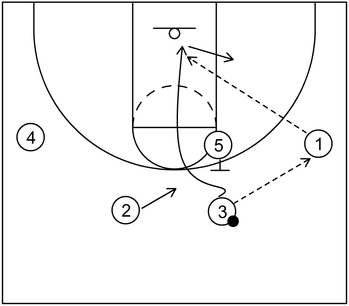
Next, 1 receives the ball from 3 and after that, 3 cuts to the basket via the back screen set by 5 while 2 fills the top.
If 3 is open, then 3 could receive the ball from 1 and score at the rim with a layup or dunk. If 3 is not open, then 3 could simply move out of the key to fill the vacant right side low post block.
Example 2 – Part 3
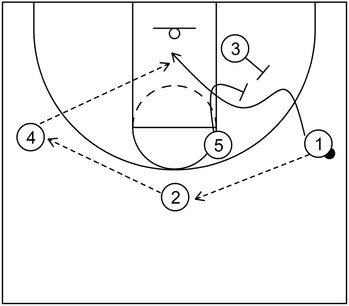
Following that, 2 receives the ball from 1 and afterwards, 4 receives the ball from 2 to complete ball reversal action.
Next, 5 could quickly cut towards the mid-post to set a double angled back screen with 3. From there, 1 could cut to the basket by way of those back screens, receive the ball from 4, and score at the rim.
What is an example of a back screen offensive counter
Example 1 – Part 1
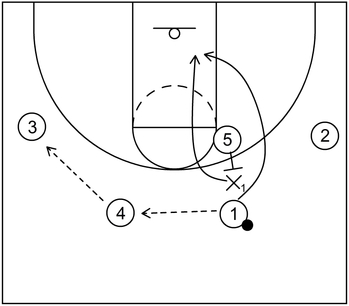
This is an example of a quick hitting offensive counter, particularly for the Chin series of the Princeton offense. To begin, 4 receives the ball from 1 and following that, 3 receives the ball from 4.
Next, 1 cuts to the basket via the back screen set by 5. However, X1 is able to jump to the ball and go over the top of the back screen, which essentially eliminates the easy scoring opportunity at the rim for 1.
Example 1 – Part 2
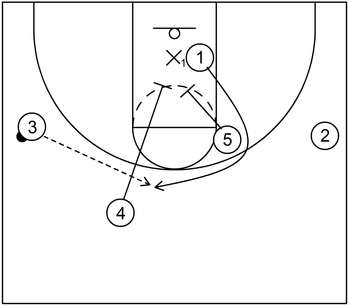
To alleviate this potential issue, 4 and 5 could set pin down screens in the lane. Afterwards, 1 could cut to the top via those down screens, receive the ball from 3, and take the three-point jump shot if open.
What are examples of back screen basketball drills
These are examples of basketball drills that seek to develop the players’ skills in utilizing the back screen.
Additionally, for drill 1 and 2, numbers are used for demonstration purposes and are not necessarily representative of standard basketball positions.
In other words, player 1 does not necessarily have to be a point guard, player 2 does not have to be a shooting guard, and so forth.
However, for drill 3, players 1, 2, and 3 are guards while players 4 and 5 are post players.
Drill 1
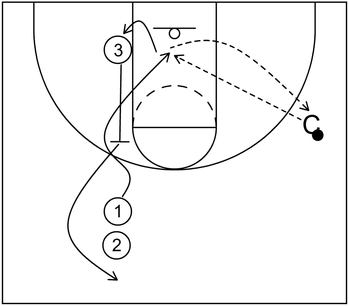
This is an example of a simple basketball drill that implements the back screen near the high post elbow area. The setup includes a line of players near the left slot, one additional player near the left side low post area, and a coach or team manager in possession of a basketball near the right side wing, indicated by the letter C.
To begin, 1 cuts to the basket via the back screen set by 3, receives the ball from the coach or manager, and scores at the rim.
Following that, 1 grabs the ball after it moves through the basket ring and then, passes it to the coach or manager. After that, 3 moves to the back of the line near the left slot to become a cutter while 1 fills the low post area to become a screener.
From that point, the drill starts again with 2 cutting to the basket via a back screen set by 1 and so forth.
Drill 2
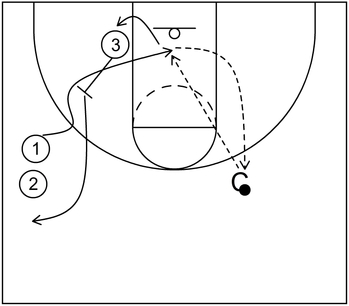
This is an example of another basketball drill that is somewhat similar to the previous one. This time, however, the back screen occurs near the left side mid-post extended area and it is an angled screen as well.
The setup includes a line of players near the left side wing, one additional player near the left side low post area, and a coach or team manager in possession of a basketball near the right slot, denoted by the letter C.
To start, 1 cuts to the basket via the angled back screen set by 3, receives the ball from the coach or manager, and scores at the rim with a layup or dunk.
Next, 1 grabs the ball after it goes through the basket ring and then, 1 passes the ball to the coach or manager. From that point, 3 moves to the back of the line near the left side wing to become a cutter while 1 fills the vacant left side low post to become a screener.
Afterwards, the drill begins once more with 2 cutting to the basket via a back screen set by 1 and so on.
Drill 3 – Part 1
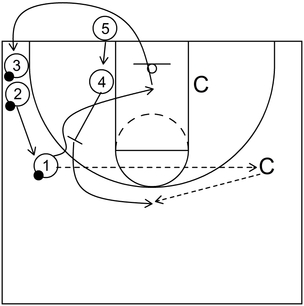
This is an example of a basketball drill that features back screen action as well as pick and pop action, primarily for the team’s best three-point shooting post players.
It is derived from Developing Interchangeable Perimeter & Post Players by Matt Painter.
Also, as mentioned previously, for this drill, players 1, 2, and 3 are guards while players 4 and 5 are post players.
The setup includes a line of post players adjacent to the left side low post behind the baseline. There is also a second line for guards, each in possession of a basketball, near the left side corner behind the three-point arc.
It should also be stated that this drill could possibly have more than five players as long as guards start in the line near the corner while post players start in the line near the low post area.
Furthermore, there is a coach or team manager, indicated by the letter C, near the right side wing that will catch or pass the ball as well as another coach or manager near the right side low post that will rebound the basketball.
To start the drill, the coach or manager receives the ball from 1 via a skip pass and afterwards, 1 cuts to the basket via the back screen set by 4. Following the back screen action, 4 cuts to the top and receives the ball from the coach or manager.
At the same time, 2 steps up to fill the vacant left side wing area, 1 cuts to the back of the line near the corner, and 5 also fills the vacant left side low post area.
Drill 3 – Part 2
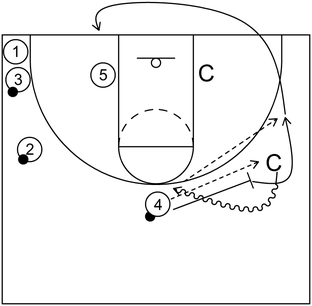
Next, 4 executes a fake pass towards 2 as if to reverse the ball but then, 4 passes the ball back to the coach or manager instead. After that, 4 follows that pass to set an on-ball screen for the coach or manager.
Following that, the coach or manager dribbles toward the top via the on-ball screen while 4 pops out to the extended wing.
From there, 4 receives the ball from the coach or manager and takes the open three-point jump shot.
After taking the shot, 4 sprints off the court and cuts to the back of the line for post players. Also, the second coach or manager could grab the ball after the shot is made or missed and pass it to a guard at the back of the line near the corner if necessary.
Moreover, after 4 goes to the back of the line for post players, 2 would start the drill again with a skip pass to the coach or manager, cut to the basket via the back screen set by 5, receive the ball again from the coach or manager, score at the rim, and so forth.